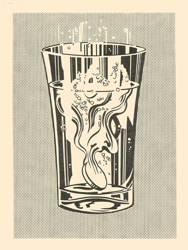Throughout Lichtenstein's career, works on paper were an integral part of his creative process. As he noted, "It's all thought up in the drawings and all accomplished in the paintings." The artist almost always began with a two-dimensional source, from which he sketched the image, recomposing it to suit narrative clarity or formal ends. Subsequently, he traced the drawing onto canvas with the aid of an opaque projector, continuing to make compositional adjustments. To accommodate the projector, drawings like Crying Girl (Study) (1964) and Ohhh . . . Alright . . . (Study) (1965) needed to be small in size. In some instances, as in Forest Scene (Study) (1980), a larger intermediate drawing was produced to further elaborate compositional details. Many of these large-scale studies were then turned into slides and projected again onto the canvas.
Lichtenstein also used drawings as a form of notation, to capture his thoughts on process. In Haystack and Haystacks (Studies) (c. 1968), detailed notes and directions for color combinations of dot patterns are indicated for studio assistants. Landscape with Rock and Chinese-Style Landscapes (Studies) (1996) tentatively explores compositional possibilities.
Over time collage became an additional tool in Lichtenstein's creative process. As his color palette expanded and his vocabulary of patterned dots and diagonals became more intricate, painted-and-cut pieces of paper enabled him to arrange complex and disparate elements. Still Life with Reclining Nude (Study) (1997) is an example of the multilayered, richly patterned collages that Lichtenstein utilized to resolve his compositions.
Rarely did Lichtenstein make drawings as fully finished works that were not used as the basis for later paintings, but, between 1961 and 1968, he produced roughly 30 of these in black and white. In Alka Seltzer (1966), he graphically summed up his earlier techniques—the emphasis on cropping and scale and the use of halftone dots—and introduced the idea of reflection, a notion that would return often in his career.
Roy Lichtenstein. Alka Seltzer, 1966. © Estate of Roy Lichtenstein. Margaret Fisher Endowment.

